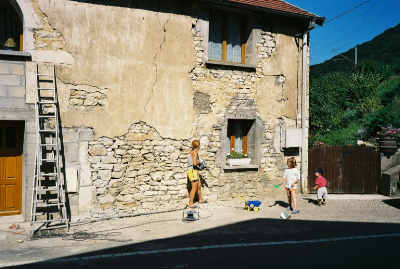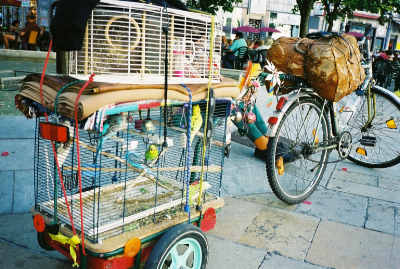Franche-Comté
It's only about 22 miles from Dannemarie to Montbéliard but the afternoon was getting on and we took the train to shorten the day's ride by a bit. Entering the region of Franche-Comté we immediately sensed a change. Gone were the lively, dressed-up wine villages of the Alsace, as well as German place names and Germanic influenced cuisine. Also gone were the tourists, at least the foreign ones. We did not meet any Americans as we biked across Franche-Comté. In fact, we did not meet a single, native English-speaker from the time we left Colmar until we arrived in the city of Beaune, located in Burgundy. What we found in this rustic, off-the-beaten track part of France were quiet roads, sleepy villages, forested hills, absolutely great food, and friendly people. Unfortunately we found very few people who spoke English. Our French is extremely rudimentary and our ability to speak German was of no use here.

A description of Franche-Comté is not complete without a mention of the food. We savored hearty fare with wonderful regional varieties of meats and cheeses. The delicious Morteau sausage made from prime pork meat, Luxeuil ham smoked in sawdust of coniferous trees. We loved Comté cheese with its hazelnut overtones and the creamy Morbier with its distinctive layer of vegetable soot through the middle. Absent from the menu were sophisticated preparations of rich reduced sauces with equally sophisticated titles that are found in the regions to the west. Being ever-hungry cyclists, it suited us just fine.
Franche-Comté finally became part of France in 1678 as Louis XIV was consolidating his holdings and building France as a world-class power. The region is bordered by the Vosges Mountains in the north, the Jura Mountains and the Swiss border to the south and east, and to the west by the region of Burgundy.

After arriving at the train station in Montbéliard we biked around the city center and found a café for lunch. Unfortunately we did not have time for extended sightseeing. Shortly after leaving the city we arrived at the banks of the Doubs River. The river provided a course of easy riding as we biked on quiet country roads through the hills of the Jura. The Rhône-Rhine canal paralleled the river and at times became one and the same. Construction of the canal was begun in 1783 and over the next several decades eventually connected two very important commercial rivers. But nowadays due to the canal's rather limited size it seems that recreational traffic is the primary user. The ambience of the canal with the lockkeeper's cottages and manually operated locks recalled a simpler, slower paced lifestyle. We arrived in the canal town of L'Isle-sur-le Doubs by late afternoon and stayed in a hotel that had seen better days. Despite some rough edges the town had a charm that grew on us. Besides, we had found a great little pizza joint for dinner.
The next day was pleasant cycling all the way to Besançon, with a few ups and downs when the road deviated from the river. The cycling couldn't have gotten much better; the sun was bright, traffic was light, and the road had enough bends and dips to keep things interesting. We stopped for lunch in Baume-les-Dames and took time to visit the former women's abbey and the Church of St. Martin.

For those who have entertained romantic notions of living in France as expatriates in some out-of-the way provincial capital, Besançon would have to be on the short list. With a population of over 100,000 and a major university, it has all the amenities one would need while taking a break from the world for a few days, or months, or whatever. A horseshoe curve of the Doubs River neatly encircles the old town on three sides. Following the river into town was a breeze and we literally bumped into the tourist office conveniently located in a shady, riverside park. We lodged at the affordable Hôtel Nord in the old town. During dinner at a small but busy outdoor café called, Le Chat Classique, ("The Classic Cat", or is it "The Classy Cat?") we decided that leaving the next morning as our plans called for would not allow for proper appreciation of the city. We just had to stay an extra day. With the decision now final we ordered another bottle of vin rouge.
Any visit to Besançon must include an excursion to la Citadelle, a spectacular fortress perched on a ridge 300 ft. above the city. From the city center it's a short steep bike ride, or one can make it in a fifteen-minute uphill hike. For those with an aversion to exercise the city bus takes a few minutes. Built between 1668 and 1711 by the famed military architect Vauban, the Citadel provides a birds-eye view of the city surrounded by the curving Doubs River. You may be thinking, "Oh, it's just another old fortress." But this one is different. It has something of interest for everyone.

Military historians will be duly impressed with it's ramparts, watchtowers, interior layout, and strategic setting. Inside one can chose from a selection of museums and exhibits such as the Franche-Comté Museum of local traditions, history, and folk art. The Museum of the Resistance and Deportations is a poignant testimony to the struggle of the French people during WWII. For those who enjoy nature there's a natural history exhibition that includes an aquarium of local aquatic life, an insectarium, and a noctarium of nighttime creatures who inhabit the region. Finally, along the back section of la Citadelle is a zoo featuring tigers, monkeys, parrots and other exotica.
In the city, on the way up to the fortress, we passed under the Porte Noir. The Romans built this triumphal stone arch in the 2nd century. Carvings of nearly life-sized legionnaires can still be seen on the almost 2000 year old structure. On the other side of the arch is the Cathedrale St-Jean, whose interior is a potpourri of styles from the 12th to the 18th centuries. An outside door of the church leads to an exhibit of the remarkable Horloge Astronomique. This incredible astrological clock has 70 dials that report over 100 terrestrial and celestial positions, and includes an hourly appearance of Jesus leaping from the tomb!
The river provided an uncomplicated exit from Besançon. We followed its course for about ten miles and with some concern departed from its familiarity as we headed for the day's destination, the town of Arbois. The hills of the Jura loomed ahead. We had our trusty Michelin map but with a scale of 1:200,000 it did not provide contour lines to assist in plotting a route. We were pleasantly surprised to find the countryside consisted of gentle undulations all the way to Arbois. The only real sweat came with the 92-degree day, the warmest of the trip. In fact our entire journey was bathed in wall-to-wall sunshine everyday with temperatures in the 80's. The only exception was the short, end of the day shower back in Colmar. Remember what we said about August?
 On the way to Arbois we stopped to visit Saline Royale, a World Heritage site in the village of Arc-et-Senans. The renowned French architect Claude-Nicolas Ledoux built the complex in the 1770's for the production of salt. It is an elegant vision of a utopian work environment at the beginning of the Industrial Revolution. Although never completely finished it consists of 11 buildings used for the production and warehousing of salt as well as housing trades important to the operation. The buildings are arranged in a semi circle around the Director's Residence pictured here between two salt storehouses. There are exceptional details in the construction of the complex that could be considered futuristic for the time and raised the bar substantially for commercial architecture of the era. Brine was piped 14 miles from its source to Saline Royale via wooden pipes. The site was chosen for its proximity to the source of fuel, Forêt de Chaux (Forest of Chaux). Operations ceased at the saltworks in 1895. We also toured an enlightening museum containing 60 small-scale models of Ladoux's visionary works. His buildings can be found in major French cities as a legacy to his genius.
On the way to Arbois we stopped to visit Saline Royale, a World Heritage site in the village of Arc-et-Senans. The renowned French architect Claude-Nicolas Ledoux built the complex in the 1770's for the production of salt. It is an elegant vision of a utopian work environment at the beginning of the Industrial Revolution. Although never completely finished it consists of 11 buildings used for the production and warehousing of salt as well as housing trades important to the operation. The buildings are arranged in a semi circle around the Director's Residence pictured here between two salt storehouses. There are exceptional details in the construction of the complex that could be considered futuristic for the time and raised the bar substantially for commercial architecture of the era. Brine was piped 14 miles from its source to Saline Royale via wooden pipes. The site was chosen for its proximity to the source of fuel, Forêt de Chaux (Forest of Chaux). Operations ceased at the saltworks in 1895. We also toured an enlightening museum containing 60 small-scale models of Ladoux's visionary works. His buildings can be found in major French cities as a legacy to his genius.
Arbois is a wine town. It's surrounded by vineyards and we were surprised to find that the department of Jura has its own Route du Vin stretching southwest from Arbois along the northeast slopes of the Jura Mountains. Has anyone heard of wines from the Jura appellations? There are a small variety of whites and reds along with an excellent rosé. There are also some unique local offerings. One is vin jaune, a golden wine allegedly flavored with walnuts. Another dessert wine, vin de paille, is made with grapes dried on beds of straw. The taste is somewhat reminiscent of the Tokay wines of Hungary.
 Arbois is the boyhood home of Louis Pasteur and there are three museums in town in his honor. The town center is Place de la Liberté where one finds some smart little shops. We bought a bottle of Jura wine from the well-appointed store of local winemaker Henri Marie, and chocolate from the shop of H. Hirsinger. We lodged at the homey Hôtel des Messageries.
Arbois is the boyhood home of Louis Pasteur and there are three museums in town in his honor. The town center is Place de la Liberté where one finds some smart little shops. We bought a bottle of Jura wine from the well-appointed store of local winemaker Henri Marie, and chocolate from the shop of H. Hirsinger. We lodged at the homey Hôtel des Messageries.
The next morning we left for Dole. We enjoyed a pleasant ride through farmland, tiny rural communities, and a section of the Forêt de Chaux. Dole is a former capital of Franche-Comté with a population of about 25,000. It now dozes unpretentiously along the banks of the Doubs River. After lunch at an outdoor café we toured the impressive Collegiate Church of Notre-Dame. But we couldn't spend the night in Dole as originally planned. We still had a day to make up due to the extra night spent in Besançon. Instead of biking into Burgundy we hopped a train to Beaune and entered a new region.
If you don't have PowerPoint on your computer you may download a viewer at: Microsoft PowerPoint Download
If you want to see the photographs individually just click on the thumbnails below.




.
.
.
.
Click here to go to the next page - Burgundy
E-mail us if you have questions or comments.
Links
France 2001 Home Page
Next page for France 2001 - Burgundy